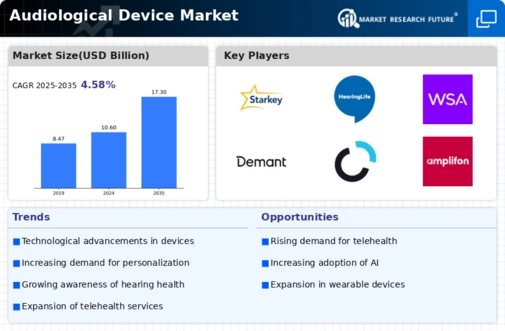Market Growth Projections
The Global Audiological Device Market Industry is projected to experience substantial growth in the coming years. With an estimated market value of 10.6 USD Billion in 2024, the industry is anticipated to expand further, reaching 17.3 USD Billion by 2035. This growth trajectory indicates a compound annual growth rate of 4.58% from 2025 to 2035. Factors contributing to this growth include the rising prevalence of hearing loss, technological advancements, and increased awareness of hearing health. The market's expansion reflects the growing recognition of the importance of audiological devices in enhancing communication and overall quality of life for individuals with hearing impairments.
Rising Prevalence of Hearing Loss
The increasing incidence of hearing loss globally serves as a primary driver for the Global Audiological Device Market Industry. According to estimates, approximately 466 million people worldwide experience disabling hearing loss, a figure projected to rise significantly in the coming years. This growing demographic necessitates the adoption of audiological devices, including hearing aids and cochlear implants, to enhance communication and quality of life. As awareness of hearing health expands, the demand for innovative solutions is likely to grow, contributing to the market's expansion. The Global Audiological Device Market Industry is expected to reach 10.6 USD Billion by 2024, reflecting this urgent need.
Government Initiatives and Support
Government initiatives and support for hearing health are emerging as a vital driver for the Global Audiological Device Market Industry. Various countries are implementing policies to improve access to audiological services and devices, recognizing the impact of hearing loss on public health and quality of life. Funding programs, subsidies, and awareness campaigns are being introduced to facilitate access to audiological devices, particularly for underserved populations. These initiatives not only promote the adoption of hearing aids and cochlear implants but also encourage research and development in the field. As governments continue to prioritize hearing health, the market is likely to benefit from increased investment and support.
Aging Population and Demographic Shifts
The aging population is a significant factor influencing the Global Audiological Device Market Industry. As life expectancy increases, a larger segment of the population is entering age groups where hearing loss becomes more prevalent. This demographic shift is particularly pronounced in developed countries, where the proportion of elderly individuals is rising. Consequently, there is a growing need for audiological devices to address age-related hearing impairments. The market is poised for growth as healthcare providers and policymakers prioritize hearing health in aging populations, thereby driving demand for audiological solutions. This trend is expected to contribute to a compound annual growth rate of 4.58% from 2025 to 2035.
Technological Advancements in Audiological Devices
Technological innovation plays a crucial role in shaping the Global Audiological Device Market Industry. Recent advancements in digital signal processing, wireless connectivity, and artificial intelligence have led to the development of more sophisticated hearing aids and cochlear implants. These devices now offer features such as noise cancellation, smartphone integration, and personalized sound profiles, which enhance user experience and satisfaction. As manufacturers continue to invest in research and development, the market is likely to witness a surge in demand for these advanced products. This trend suggests that the Global Audiological Device Market Industry will experience robust growth, potentially reaching 17.3 USD Billion by 2035.
Increased Awareness and Education on Hearing Health
There is a notable increase in awareness and education regarding hearing health, which is positively impacting the Global Audiological Device Market Industry. Campaigns aimed at promoting hearing health and the importance of early intervention are gaining traction globally. Organizations and healthcare providers are actively engaging in outreach efforts to educate the public about the risks of untreated hearing loss and the benefits of using audiological devices. This heightened awareness is likely to lead to an increase in demand for hearing aids and other audiological solutions, as individuals become more proactive about their hearing health. As a result, the market is expected to expand significantly in the coming years.





















Leave a Comment